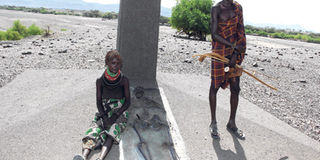‘Turkana Boy’ fossil opens up remote village for tourists and scholars

Ekiru Ewaton and his wife Esekon Lowa, at the artistic impression of a fossil of a 1,600,000-year-old pre-modern human known as the ‘Turkana Boy’, which was discovered in Nariokotome in Turkana in 1984.
JARED NYATAYA | NATION MEDIA GROUP
What you need to know:
- It is in this remote village that a Kenyan palaeontologist, Mr Kamoya Kimeu, who was part of the team led by Dr Richard Leakey, a palaeoanthropologist, discovered a 1.6 million-year-old fossil in 1984 and named it Turkana Boy or Nariokotome Boy.
- “The fossils were discovered at a place where we had built our manyatta and we have renamed him Ekiru since we believe he was born during the rainy season,” explained Mrs Lowa.
- Governor Josphat Nanok said: “The story of Turkana County, as the cradle of mankind, will now be well told when people visit this site that has been a bare land.
The once-neglected rocky village in Turkana County is gaining international recognition after a monument, with a replica of the world’s most complete early hominid ever discovered, was erected.
The monument at Nariokotome village is attracting local and international scholars, reviving Kenya’s fame as the epicentre of studies on human evolution.
It is in this remote village that a Kenyan palaeontologist, Mr Kamoya Kimeu, who was part of the team led by Dr Richard Leakey, a palaeoanthropologist, discovered a 1.6 million-year-old fossil in 1984 and named it Turkana Boy or Nariokotome Boy.
The local community has, however, embraced it as one of their own and even nicknamed the fossil Brian Ekiru, and appointed a family that shares the surname to have the fossil as one of their children.
Mr Ewoton Ekiru and Mrs Esekon Lowa are now in charge of the site where the fossil was discovered, which has already been demarcated by the Turkana County Government as one of the over 50 tourist sites in the county.
INCHARGE OF THE MONUMENT
“The fossils were discovered at a place where we had built our manyatta and we have renamed him Ekiru since we believe he was born during the rainy season,” explained Mrs Lowa.
The mother of seven is now in charge of the monument and no one can access the site without her notice and permission.
About 50 metres from the monument is Esekon, an evergreen tree found in the arid Turkana, which the locals take as an indication that the site is a blessed place.
The tree provides shade for Mrs Lowa, who is always at the site to ensure anyone visiting the site has a guide, at least before the monument is formally launched by the authorities.
The villagers said that in Turkana culture, children are named by just describing the environment in which they are born.
She said that there was no argument in choosing a name for the Turkana boy despite the scientific fact that he died over 1.6 million years ago.
The village is about 130 kilometres north of Lodwar Town or about two hours drive on a dusty and bumpy road through Kalokol. “Now that scholars are flocking to this place, the government should consider tarmacking the road and empowering the local community to benefit from the discovery,” said Mr Asukuru Ewoton, one of the residents.
Mr Ewoton said that the more than 800 villagers living around the monument settled on the name Ekiru because water was their main challenge.
He said locals have embraced and love Ekiru, with the hope that more Ekirus will be born to signify abundance of rain.
Besides rains, they expect that the area will soon be a town visited by many foreign tourists.
The Turkana County Government spent over Sh20 million to erect the now cherished and much visited monument that is also located west of Lake Turkana, the world’s largest desert lake.
Governor Josphat Nanok said: “The story of Turkana County, as the cradle of mankind, will now be well told when people visit this site that has been a bare land.
MONUMENTS LAUNCH
“An exhibition and interpretation room will be available for the visitors,” said Mr Nanok.
Mr Nanok said his government was working with the National Museums of Kenya and the Turkana Basin Institute to maintain and conserve the monument.
He said that President Uhuru Kenyatta and Tourism Cabinet Secretary Phyllis Kandie, were expected to launch the monument as a Kenyan tourism site.
The villagers said the region was safe because it has never had any incident of cattle rustling from its neighbours, the Merille Community of Ethiopia who, they said, lived far away.





